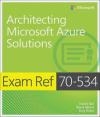Exam Ref 70-534 Architecting Microsoft Azure Solutions
Steve Maier, Dan Stoltz, Haishi Bai
Exam Ref 70-534 Architecting Microsoft Azure Solutions
Steve Maier, Dan Stoltz, Haishi Bai
- Producent: Microsoft
- Rok produkcji: 2015
- ISBN: 9780735697447
- Ilość stron: 432
- Oprawa: Miękka
Niedostępna
Opis: Exam Ref 70-534 Architecting Microsoft Azure Solutions - Steve Maier, Dan Stoltz, Haishi Bai
Prepare for Microsoft Exam 70-534--and help demonstrate your real-world mastery of Microsoft Azure solution design and architecture. Designed for experienced IT pros ready to advance their status, Exam Ref focuses on the critical-thinking and decision-making acumen needed for success at the Microsoft Specialist level. Focus on the expertise measured by these objectives: * Describe Microsoft Azure infrastructure and networking* Help secure resources* Design an application storage and data access strategy* Design an advanced application* Design websites* Design a management, monitoring, and business continuity strategyThis Microsoft Exam Ref: * Organizes its coverage by exam objectives* Features strategic, what-if scenarios to challenge you* Assumes you have experience designing Microsoft Azure cloud or hybrid solutions and supporting application life cycle managementIntroduction xv Microsoft certifications xv Acknowledgments xvi Free ebooks from Microsoft Press xvi Microsoft Virtual Academy xvi Errata, updates, & book support xvi We want to hear from you xvii Stay in touch xvii Preparing for the exam xviii Chapter 1: Design Microsoft Azure infrastructure and networking 1 Objective 1.1: Describe how Azure uses Global Foundation Services (GFS) datacenters 2 Azure's global footprints 2 Designing cloud-scale datacenters 4 Designing for the cloud 8 Objective summary 11 Objective review 12 Objective 1.2: Design Azure virtual networks, networking services, DNS, DHCP, and IP addressing configuration 12 Creating a cloud-only virtual network 13 Understanding Access Control Lists and Network Security Groups 18 Objective summary 22 Objective review 22 Objective 1.3: Design Azure Compute 23 Selecting VM sizes 24 Managing images 31 Managing VM states 33 Capturing infrastructure as code 36 Scaling applications on VMs 40 Objective summary 44 Objective review 44 Objective 1.4: Describe Azure virtual private network (VPN) and ExpressRoute architecture and design 45 Designing hybrid solutions with Virtual Network and ExpressRoute 45 ExpressRoute 48 vNet-to-vNet VPN 49 Multi-site VPN 50 Understanding other hybrid solution options 51 Objective summary 52 Objective review 52 Objective 1.5: Describe Azure Services 52 Using Azure Traffic Manager 53 Using CDN 54 Objective summary 55 Objective review 55 Answers 56 Objective 1.1: Thought experiment 56 Objective 1.1: Review 56 Objective 1.2: Thought experiment 57 Objective 1.2: Review 57 Objective 1.3: Thought experiment 58 Objective 1.3: Review 58 Objective 1.4: Thought experiment 59 Objective 1.4: Review 59 Objective 1.5: Thought experiment 60 Objective 1.5: Review 60 Chapter 2: Secure resources 63 Objective 2.1: Secure resources by using managed identities 63 Understanding claims-based architecture 64 Understanding basic authentication and authorization workflow 66 Working with native clients and multitiered applications 67 Working with multitiered applications 68 Additional scenarios 69 Azure Active Directory 69 A sample scenario with ADAL and Visual Studio 71 Azure AD Graph API 74 Objective summary 76 Objective review 76 Objective 2.2: Secure resources by using hybrid identities 77 Setting up directory synchronization with AD FS 77 Configuring Azure AD Application Proxy 82 Objective summary 85 Objective review 86 Objective 2.3: Secure resources by using identity providers 86 Understanding Azure ACS 87 Using Azure ACS with AD FS 89 Using Azure ACS with social networks 90 Using identity providers with ASP.NET applications 90 Using external identity providers with Azure Mobile Services 94 Objective summary 94 Objective review 95 Objective 2.4: Identify an appropriate data security solution 95 Understanding data protection technologies 96 Implementing effective access control policies 98 Using data reliability and disaster recovery services 102 Understanding Azure Rights Management Services 106 Managing security keys with Azure Key Vault 107 Objective summary 108 Objective review 108 Objective 2.5: Design a role-based access control strategy 109 Understanding access control challenges faced by large enterprises 109 Implementing RBAC 110 Using RBAC for Azure resources 111 Empowering users with self-service 112 Using Azure AD Access Panel 115 Managing devices with Azure AD Device Registration Service 116 Improving security policies over time 117 Objective summary 120 Objective review 120 Answers 122 Objective 2.1: Thought experiment 122 Objective 2.1: Review 122 Objective 2.2: Thought experiment 123 Objective 2.2: Review 123 Objective 2.3: Thought experiment 124 Objective 2.3: Review 124 Objective 2.4: Thought experiment 125 Objective 2.4: Review 126 Objective 2.5: Thought experiment 127 Objective 2.5: Review 127 Chapter 3: Design an application storage and data access strategy 129 Objective 3.1: Design data storage 129 Designing storage options for data 130 Designing security options for SQL Database or Storage 136 Identifying the appropriate VM type and size for the solution 137 Objective summary 139 Objective review 140 Objective 3.2: Design applications that use Mobile Services 141 Azure Mobile Services 141 Consuming Mobile Services 143 Offline Sync 145 Implementing Mobile Services 147 Secure Mobile Services 148 Extending Mobile Services by using custom code 150 Objective summary 151 Objective review 151 Objective 3.3: Design applications that use notifications 153 Implementing push notification services in Mobile Services 153 Sending push notifications 155 Objective summary 157 Objective review 157 Objective 3.4: Design applications that use a web API 158 Implementing a custom Web API 159 Scaling by using Azure App Service Web Apps 161 WebJobs 163 Securing a Web API 165 Objective summary 167 Objective review 168 Objective 3.5: Design a data access strategy for hybrid applications 168 Connect to on-premises data by using Azure Service Bus Relay 169 Azure App Service BizTalk API Apps Hybrid Connections 170 Web Apps virtual private network capability 171 Identify constraints for connectivity with VPN 172 Identify options for domain-joining Azure Virtual Machines and Cloud Services 172 Objective summary 174 Objective review 174 Objective 3.6: Design a media solution 175 Azure Media Services overview 175 Key components of Media Services 176 Objective summary 179 Objective review 179 Answers 180 Objective 3.1: Thought experiment 180 Objective 3.1: Review 180 Objective 3.2: Thought experiment 181 Objective 3.2: Review 181 Objective 3.3: Thought experiment 183 Objective 3.3: Review 183 Objective 3.4: Thought experiment 184 Objective 3.4: Review 185 Objective 3.5: Thought experiment 185 Objective 3.5: Review 186 Objective 3.6: Thought experiment 187 Objective 3.6: Review 187 Chapter 4: Design an advanced application 189 Objective 4.1: Create compute-intensive applications 190 Using Azure in a high-performance computing environment 190 Using Azure Batch 193 Understanding Azure Batch Apps 199 Implementing the Competing Consumers pattern 200 Objective summary 202 Objective review 202 Objective 4.2: Create long-running applications 203 Designing available applications 203 Designing reliable applications 207 Designing scalable applications 211 Using Azure Autoscale 213 Using Cloud Services 215 Sample scenario: Cloud Services basics 217 Objective summary 220 Objective review 220 Objective 4.3: Select the appropriate storage option 221 Understanding data access patterns 222 Selecting a data storage solution 224 Evaluating data storage qualities 226 Objective summary 228 Objective review 228 Objective 4.4: Integrate Azure services in a solution 229 Creating data-centric web applications 230 Working with Big Data and the Internet of Things 233 Building enterprise mobile applications 236 Creating media applications 238 Managing related services 240 Objective summary 241 Objective review 242 Answers 243 Objective 4.1: Thought experiment 243 Objective 4.1: Review 243 Objective 4.2: Thought experiment 244 Objective 4.2: Review 244 Objective 4.3: Thought experiment 246 Objective 4.3: Review 246 Objective 4.4: Thought experiment 247 Objective 4.4: Review 248 Chapter 5: Design Web Apps 251 Objective 5.1: Design web applications for scalability and performance 252 Globally scale websites 252 Create websites using Microsoft Visual Studio 254 Debug websites 257 Understand supported languages 259 App Service Web Apps, Azure Virtual Machines, and Azure Cloud Services 263 Objective summary 268 Objective review 268 Objective 5.2: Deploy websites 268 Implement Azure Site Extensions 269 Create packages 271 App Service Plan 273 Deployment slots 275 Resource groups 277 Publishing options 278 Objective summary 285 Objective review 285 Objective 5.3: Design websites for business continuity 286 Scale-up and scale-out with App Service Web Apps and Azure SQL Database 287 Configure data replication patterns 289 Update websites with minimal downtime 291 Backup and restore data 291 Design for disaster recovery 294 Deploy websites to multiple regions for high availability 294 Design data tier 296 Objective summary 298 Objective review 299 Answers 300 Objective 5.1: Thought experiment 300 Objective 5.1: Review 300 Objective 5.2: Thought experiment 301 Objective 5.2: Review 302 Objective 5.3: Thought experiment 303 Objective 5.3: Review 303 Chapter 6: Design a management, monitoring, and business continuity strategy 305 Objective 6.1: Evaluate hybrid and Azure-hosted architectures for Microsoft System Center deployment 306 Understanding System Center components supported in Azure 306 System Center deployment 309 Design considerations for managing Azure resources with System Center 310 Understanding which scenarios dictate a hybrid scenario 312 Objective summary 315 Objective review 315 Objective 6.2: Design a monitoring strategy 316 Identify the Microsoft products and services for monitoring Azure solutions 317 Understand the capabilities of System Center for monitoring an Azure solution 317 Understand built-in Azure capabilities 322 Identify third-party monitoring tools, including open source 323 Describe use-cases for Operations Manager, Global Service Monitor, and Application Insights 323 Describe the use cases for WSUS, Configuration Manager, and custom solutions 325 Describe the Azure architecture constructs and how they affect a patching strategy 327 Objective summary 329 Objective review 330 Objective 6.3: Design Azure business continuity/disaster recovery (BC/DR) capabilities 330 Understand the architectural capabilities of business continuity and disaster recovery 331 Describe Hyper-V Replica and Azure Site Recovery 336 Describe use-cases for Hyper-V Replica and Azure Site Recovery 338 Objective summary 340 Objective review 340 Objective 6.4: Design a disaster recovery strategy 341 Design and deploy Azure Backup and other Microsoft backup solutions for Azure 342 Understand use-cases when StorSimple and Data Protection Manager would be appropriate 351 Objective summary 352 Objective review 353 Objective 6.5: Design Azure Automation and PowerShell workflows 354 Create a Windows PowerShell script specific to Azure 354 Objective summary 363 Objective review 364 Objective 6.6: Describe the use cases for Azure Automation configuration 365 Desired State Configuration 366 Windows PowerShell for automation 368 Chef and Puppet 368 Azure Automation 369 Objective summary 370 Objective review 370 Answers 372 Objective 6.1: Thought experiment 372 Objective 6.1: Review 372 Objective 6.2: Thought experiment 373 Objective 6.2: Review 374 Objective 6.3: Thought experiment 374 Objective 6.3: Review 375 Objective 6.4: Thought experiment 376 Objective 6.4: Review 376 Objective 6.5: Thought experiment 377 Objective 6.5: Review 377 Objective 6.6: Thought experiment 378 Objective 6.6: Review 379 Index 381
Szczegóły: Exam Ref 70-534 Architecting Microsoft Azure Solutions - Steve Maier, Dan Stoltz, Haishi Bai
Tytuł: Exam Ref 70-534 Architecting Microsoft Azure Solutions
Autor: Steve Maier, Dan Stoltz, Haishi Bai
Producent: Microsoft
ISBN: 9780735697447
Rok produkcji: 2015
Ilość stron: 432
Oprawa: Miękka
Waga: 0.7 kg


















